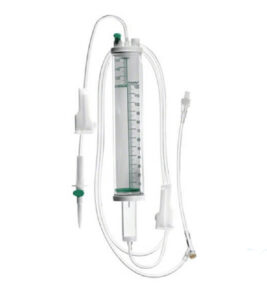Microset vs. Infusion Set: A Precise Choice for Safe and Effective Injections
In the field of medical equipment, selecting the correct tool for intravenous (IV) injection plays a vital role in a patient’s health and recovery. Both microsets and infusion sets are commonly used in hospital injection departments, but there are key differences between them that healthcare professionals and even patients need to be aware of. This article from Sayeh Gostar Salamat will comprehensively examine these differences to help you make a more informed choice.

What is a Microset?
A microset is a medical device that acts as an interface between an IV bag and a venous catheter (such as an angiocatheter or scalp vein). Its main purpose is the controlled and precise injection of a specific volume of medication or fluids into the patient’s body.
Key Features of a Microset:
- Graduated Chamber (Burette): The most important feature of a microset is its graduated chamber (burette), which allows for precise control over the injection volume. This chamber usually has a capacity of 100 or 150 milliliters.
- High Accuracy: Microsets are ideal for injecting diluted and dose-sensitive medications, preventing dosing errors.
- Prevention of Hypervolemia: By precisely controlling fluid volume, microsets help prevent hypervolemia (over-infusion of fluids), which is crucial for patients with specific conditions (such as heart or kidney failure).
- Filtration Filters: This device is equipped with precise air and fluid filters (usually with a 15-micron accuracy) that prevent unwanted particles from entering the patient’s bloodstream.
- Drip Rate: The drip rate of a microset is usually high, delivering 60 drops per milliliter, which allows for precise adjustment of the infusion rate.
What is an Infusion Set?
An infusion set (IV Administration Set) is also an intravenous injection device used to deliver large volumes of fluids or medications into a patient’s vein. This device directly connects the IV bag or bottle to the patient’s body.
Key Features of an Infusion Set:
- Simpler Design: An infusion set has a simpler structure compared to a microset.
- Large-Volume Injections: This set is suitable for large and long-term infusions, such as glucose solutions, electrolyte solutions, or fluid replacement.
- Absence of Graduated Burette: An infusion set lacks a graduated burette, making precise dose control more difficult, and it is primarily regulated by the flow rate of drops.
- Drip Rate: The drip rate in infusion sets (sometimes called macrosets) is usually lower, providing 10, 15, or 20 drops per milliliter, depending on the type of set.
Microset vs. Infusion Set Comparison: Which Option is More Suitable?
| Feature | Microset | Infusion Set |
| Controllable Volume | Precise and Limited (100 or 150 mL) | Unlimited and Large |
| Graduated Chamber (Burette) | Yes | No |
| Drip Rate | Approximately 60 drops per milliliter | Approximately 10 to 20 drops per milliliter |
| Primary Use | High-precision diluted medication infusion | Fluid and electrolyte replacement |
| Suitable For | Children, cardiac patients, sensitive medications | Adults, routine and large-volume infusions |
| Precise Dose Control | Very High | Lower |
When is a Microset Used?
- Need for Slow and Precise Injection: For medications that require slow and precise infusion to maintain a specific plasma concentration.
- Sensitive Patients: In children, cardiac patients, renal patients, or the elderly who require strict control over fluid volume and medication doses.
- Drugs with a Narrow Therapeutic Window: When the exact dose of a drug is critical, and the slightest change can cause serious side effects.
- Prevention of Complications: To prevent hypervolemia and other complications resulting from rapid or excessive fluid infusion.
When is an Infusion Set Used?
- Large and Long-Term Infusions: For delivering large volumes of fluids such as glucose solutions (dextrose), saline, or Ringer’s lactate.
- Fluid and Electrolyte Replacement: In dehydrated patients or those with low blood pressure or electrolyte imbalances.
- Nutrient Delivery: For continuous infusion of nutrients, vitamins, or electrolytes.

Final Summary
Despite their superficial similarities, microsets and infusion sets have entirely different applications. The choice between the two directly depends on the type of medication, the patient’s clinical condition, the infusion volume, and the required level of precision. A correct understanding of these differences allows physicians and nurses to make safe and effective choices, leading to better patient outcomes.
At Sayeh Gostar Salamat, we are committed to providing the best types of microsets and infusion sets with guaranteed quality and in compliance with international standards. To purchase microsets and other intravenous injection equipment with the best quality and reasonable prices, simply contact our experts for free specialized consultation.









No comment